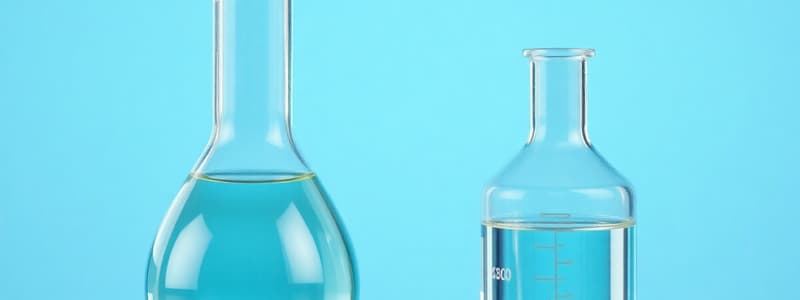Podcast
Questions and Answers
What defines a strong electrolyte?
What defines a strong electrolyte?
- Substances that partially dissociate in a solution.
- Substances that are completely dissociated in an aqueous solution. (correct)
- Substances that do not conduct electricity in solution.
- Substances that form gas when dissolved in water.
Which of the following is an example of a strong electrolyte?
Which of the following is an example of a strong electrolyte?
- Ethyl alcohol
- Glucose
- Sodium chloride (correct)
- Sugar
Which of the following statements about electrolytes is true?
Which of the following statements about electrolytes is true?
- All substances can be classified as either electrolytes or nonelectrolytes.
- Weak electrolytes completely dissociate in aqueous solutions.
- Strong electrolytes can conduct electricity in solution. (correct)
- Nonelectrolytes are better at conducting electricity than electrolytes.
Which substance mentioned is classified as a nonelectrolyte?
Which substance mentioned is classified as a nonelectrolyte?
What is a characteristic of a solution containing a strong electrolyte?
What is a characteristic of a solution containing a strong electrolyte?
Which option correctly describes the components of electrolytes?
Which option correctly describes the components of electrolytes?
What property of electrolytes is essential for their function?
What property of electrolytes is essential for their function?
Which statement is true about the nature of electrolytes?
Which statement is true about the nature of electrolytes?
What is NOT a characteristic of electrolytes?
What is NOT a characteristic of electrolytes?
Which of the following statements regarding electrolytes is accurate?
Which of the following statements regarding electrolytes is accurate?
Flashcards
Electrolytes
Electrolytes
Substances that form ions when dissolved in a solvent, like water.
Ions
Ions
Charged particles, either positively or negatively charged.
Conductivity
Conductivity
The ability to conduct electricity.
Covalent Bonds
Covalent Bonds
Signup and view all the flashcards
Polar Molecules
Polar Molecules
Signup and view all the flashcards
Strong Electrolytes
Strong Electrolytes
Signup and view all the flashcards
Nonelectrolytes
Nonelectrolytes
Signup and view all the flashcards
Electrolyte Solution
Electrolyte Solution
Signup and view all the flashcards
Nonelectrolyte Solution
Nonelectrolyte Solution
Signup and view all the flashcards
Dissociation
Dissociation
Signup and view all the flashcards
Study Notes
Course Information
- Course title: Pharmaceutical Analytical Chemistry 1 (PC101)
- Level: 1
- Department: Pharmaceutical Analytical Chemistry
- Faculty: Pharmacy, Mansoura University
- Instructors: Prof. Dr. Jenny Jeehan Nasr, Dr. Galal Magdy, Dr. Heba Samir Elama
Learning Outcomes
- Students will learn about:
- Chemistry
- Solution Terminology
- Solubility
- Mole Concept
- Concentration units
- Stoichiometry of reaction
Analytical Chemistry
- Qualitative Analysis: Identifying analytes (e.g., by color, taste, physical properties, solubility)
- Quantitative Analysis: Determining the concentration or amount of a substance (e.g., through determination, estimation, or assay)
Solution Terminology
- Solvent: A substance that dissolves other materials to form a solution
- Solute: A substance that dissolves in a solvent
- Solution: A homogenous mixture of one or more solutes dissolved in a solvent
Concentration
- Concentrated solution: A solution with a relatively large proportion of solute to solvent
- Diluted solution: A solution with a relatively smaller proportion of solute to solvent
Solution Saturation
- Unsaturated solution: A solution that can dissolve a further amount of solute at a specific temperature
- Saturated solution: A solution which cannot dissolve a further amount of solute at a specific temperature
- Supersaturated solution: A solution with more solute than required to saturate it at a given temperature; this solution is unstable
Electrolytes and Nonelectrolytes
- Nonelectrolytes: Molecular substances that do not dissociate in water; their solutions do not conduct electricity (e.g., sugar, ethyl alcohol)
- Electrolytes: Substances that dissociate in water; their solutions conduct electricity
- Strong electrolytes: Substances that completely dissociate in water (e.g., NaCl, strong acids, strong bases)
- Weak electrolytes: Substances that dissociate to a small extent in water (e.g., acetic acid, water, NH4OH, HCN)
Mole Concept
- Atoms and molecules are extremely small in size and mass
- Moles are standard scientific units for measuring very small entities (atoms, molecules)
- 1 mole = 6.022 x 1023 atoms/molecules/particles
- This is Avogadro's number
- Formula Weight (or Molecular Weight): The sum of the atomic weights of all atoms in a compound
Concentration Units
- Molarity (M): The number of moles of solute per liter of solution
- Molarity = Moles of solute / Liters of solution
- Normality (N): The number of equivalent weights of solute per liter of solution
Stoichiometry of Reaction in Solution
- Stoichiometry deals with the quantitative relationships between reactants and products in a chemical reaction.
- Mole ratios, obtained from balanced chemical equations, are used to solve stoichiometric problems involving solutions.
Homework Examples
- Various example problems showing calculations of
- Weight of a substance in moles
- Moles of a substance in grams
- Moles to molecules
- Moles to atoms and other conversion problems. Calculations are based around specific chemical formulas.
Studying That Suits You
Use AI to generate personalized quizzes and flashcards to suit your learning preferences.




